The Six Key Components of a Safe Backyard Playset
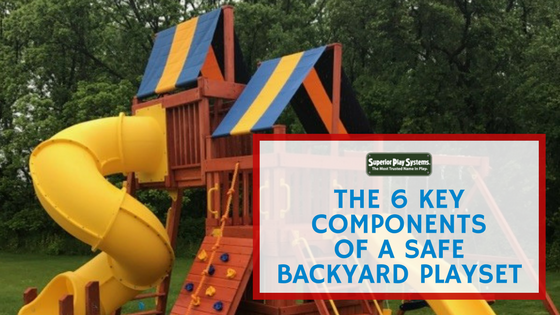
The Six Key Components of a Safe Backyard Playset
- What Material Is It Made Of?
- How Is It Being Installed
- What Surface Is It Placed On?
- Is the Playset Age-Appropriate?
- What Is The Company’s Reputation?
- Are There Any Basic Safety Hazards?
There’s nothing more entertaining and fun than a trip to the park, but those can sometimes be a bit of a project. You have to load all the kids in the van, pack snacks and a picnic blanket and you always feel like you’re neglecting things at home. And no matter how many hours you spend there, the kids almost never want to leave.
That’s why many families stop going to the park and instead bring the park home with them. They build their own playset right in their own backyard. What could be better than that?
The only problem with this is the issue of safety. At parks or school playgrounds, all the equipment has been installed by the town or the school and necessarily passes all safety inspections and regulations. When it comes to any structures you build or purchase for your own backyard, however, it’s up to you to ensure that your backyard playset is safe for your kids to play on.
Maybe safety doesn’t seem like a huge concern to you. But it’s more important than you might think. More than 200,000 children injure themselves on public and private playground equipment each year, according to the Centers for Disease Control and Prevention.
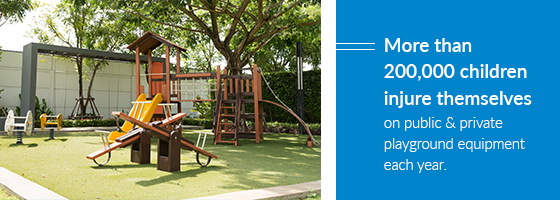
This doesn’t have to be the case, though. You can help keep your child safe by taking a few basic precautions to ensure the safety of your backyard playset.
With this goal in mind, here are a few of the things to remember when you’re thinking about the features of a safe playset.
1. What Material Is It Made Of?
Two main materials are commonly used to construct playsets. These two are metal and wood. Playsets are commonly either built entirely of wood, entirely of metal or perhaps some combination of the two. Of course, there is also the subset of toddler playsets that are made entirely of plastic, but those are in a separate category.
When we refer to the material, we’re discussing the main frame itself. Certainly, some aspects of the playset will be the same on both wood and metal playsets. For example, the slides and the belt swings will both be made of the same high-density plastic in both types of playsets, and the handhold bars will almost always be made of metal.
The frame, however, is a little more open to variation. Metal and wood are the two most common choices for this construction, and both have their advantages and their disadvantages.
Metal
Playsets that use metal for their main framework are constructed from steel and are available in a wide range of colors. The steel is usually covered with a powder-coated finish that helps protect against rusting and prevent heat retention. These features are intended to protect your children from burns and also to preserve the playset’s beauty and functionality over time.
The primary advantage of metal is its long-lasting and durable nature. Steel doesn’t rot or decay. If it’s cared for properly, it will last for years to come and provide your children and maybe even your grandchildren with years of fun.
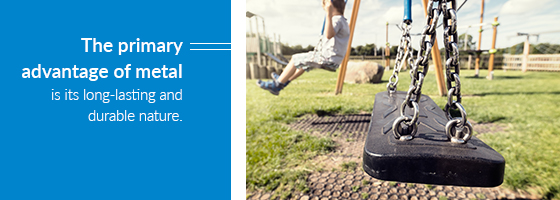
Metal playsets are also usually less expensive than wooden ones. They can also be less work, since there is no need to treat the metal regularly. They’re also lighter and are usually easier to put together than their wooden counterparts. In terms of safety features, however, metal can still cause burns or discomfort. It might cause children to let go of a bar they were holding onto because it became too hot, and they might fall to the ground.
Wood
Wood playsets offer a natural beauty that’s extremely appealing. They’re commonly built from woods like cedar and have been pressure-treated to prevent rotting and insect infestations. This treatment works to make the wood last longer and remain safer.
Wooden playsets stay cool in the summer, meaning fewer burns and less discomfort for the children playing on them. They’re also better for the environment than metal ones. They will never rust the way a metal playset might, and they are more heavy-duty, easily supporting the weight of groups of children.
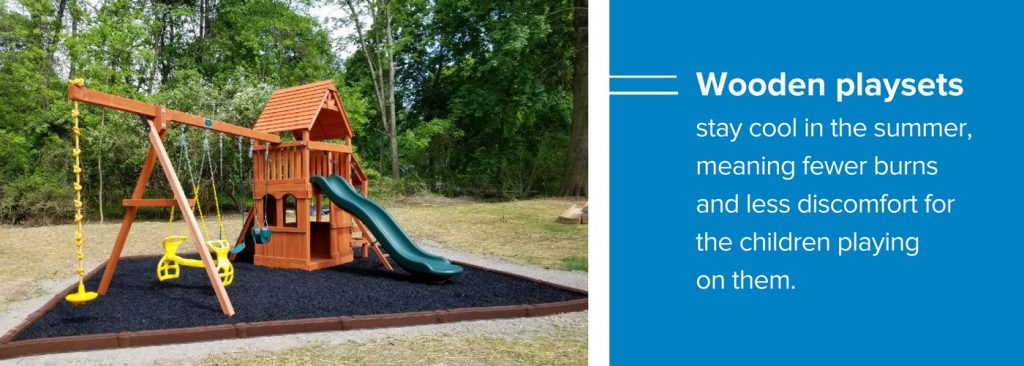
They’re also highly customizable. It’s easy to build a bit of the set, and then add to it later on. They’re also easy to repaint or restyle as the years go on.
Most wooden playsets do require a bit of upkeep. The wood must be stained and treated regularly to maintain the original look and also to prevent warping, splintering or other damage from occurring. If the wood isn’t maintained regularly, the splitting and warping can cause the bolts to become loose, and the playset can become unstable and unsafe.
However, if you’re willing to commit to this maintenance, these beautiful wooden swing sets & playsets will last for years and are much heavier and typically more stable than metal playsets.
Neither material is always safer than the other. Both have their advantages, and both will provide you and your family with years of fun if they’re taken care of properly.
2. How Is It Being Installed?
One of the most important factors of playground safety is the correct installation of the playset. If it has been installed improperly, it has the potential to cause all kinds of safety issues and hazards.
It might seem easy enough to do yourself, but we recommend against this unless you feel confident in your abilities. The security of your children as they play is too much to risk.
If a playset has been installed incorrectly, the results could be disastrous. Pieces of the playset might come apart when children are playing on them. Exposed sharp ends might be left sticking out, and could cause injury. The playset itself might even tip over if it hasn’t been anchored properly.
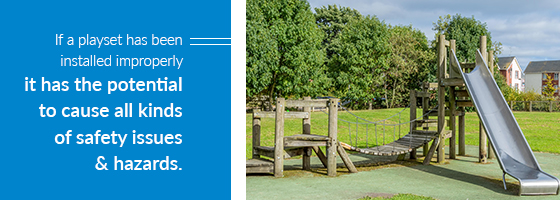
Installing a playset is a very involved process, and it’s of the utmost importance that this task is done correctly. You can certainly do it yourself, but only if you’re extremely confident in your ability to do it right. Get a set of directions and follow them to the letter. Ask a friend or relative who’s well-versed in this area to assist you, or at least to check your work when you’re finished. And if you’re determined to do this yourself, don’t let any children on the playset until you’re certain it’s finished and it’s finished correctly.
If you don’t feel confident, it’s best to let a professional handle the installation. Most companies that sell playsets also offer installations. It might be wise to spend a little extra and pay for this installation as well.
3. What Surface Is It Placed On?
No matter how hard you work to ensure the playset itself is safe, you can’t guarantee there won’t be slips and falls off the playset and onto the ground below. That’s why it’s essential to install your new playset over a soft surface. This is an easy thing to overlook, but it plays a crucial role in the safety and well-being of your children as they play on their new playset.
Obviously, there are some surfaces you shouldn’t install a playset on. For example, don’t install the playset on asphalt or concrete. If a child were to fall onto this, the injuries have the potential to be quite severe. The grass is a better choice, but it still isn’t ideal. The soft grass and the loose dirt underneath do provide a fair amount of cushioning for falls. The problem is that over years of running and jumping and falling on the ground, the grass will wear away and the dirt will become hard-packed. This means it provides less cushioning and less protection.
As for what surface to install a playset on, there are a few options to choose from. All of these are acceptable, and all have different advantages. Decide which is the most practical and beneficial for you and your playset.
Pea Gravel or Sand
Neither of these is perfect, but they both provide more protection than hard-packed dirt. They’re also relatively cheap and natural, making them environmentally friendly. You’ll need to install a barrier around the playset, however, to keep the sand or gravel from spreading into the rest of the yard.
Be careful of the sand when it gets wet, as it will become more hard-packed and will not be soft to land on. You’ll also have to rake the sand or gravel back in occasionally, as the wind might blow it outside the barrier. Lastly, you’ll have to check periodically for any hazardous objects that might be embedded in the sand.
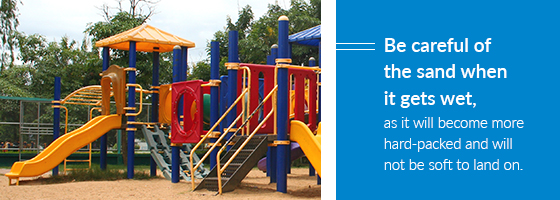
Mulch
Mulch is comparatively cheap, easy to come by and good for the environment. It’s also sturdy and unlikely to be blown away by the wind. It’s a popular choice for cushioning playgrounds because of how well it works. Many public playgrounds trust it, and it would make a terrific choice for your backyard playset as well.
Mulch does become compact every few years, so it’s necessary to add a fresh layer to the top. It also degrades naturally, so eventually, you’ll need to replace it entirely.
Shredded Rubber
This type of surface costs more than the other loose fills, but it’s still less expensive than solid rubber. It’s also an excellent way to recycle old tires.
With the shredded rubber, you’ll have to build a barrier to keep it from spreading out into the yard, and it will need to be raked back into place every so often, especially in high-traffic areas such as beneath the swings.
Rubber Mats
These have become much more popular in recent years because they fix many of the problems that come with some of the other options. They’re composed of interlocking tiles that can be made of different levels of thickness, depending on how high your playset is. These rubber mats are more likely to be long-lasting than the loose-fill options, and they won’t need to be replaced every several years. Your pets are less likely to use them as a bathroom, and even if they do, it’s easy to spot these messes and clean them up.
They are more expensive, however, and they’re also less natural-looking, meaning they might detract from the natural beauty of a wooden playset.
Poured-in-Place Rubber
This is arguably the material that offers the best protection for falls. It also happens to be the most expensive and the least natural-looking.
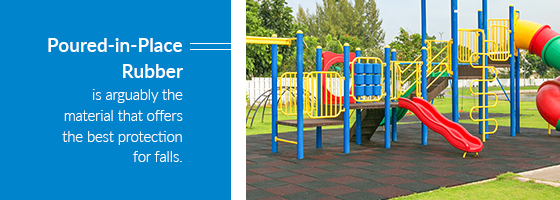
But the level of protection it offers can’t be overstated. It’s also the longest-lasting option on the list and requires no maintenance once it’s been poured into place.
No matter what surface you install the playset on, experts agree that the combined height of a child and the playset they’re standing on should be no more than 12 feet. If the playset is taller than this, no ground surface will be able to protect the child from injury if they fall.
4. Is the Playset Age-Appropriate?
Another consideration that affects the safety of your backyard playset is age-appropriateness. Exposing young children to playsets they are not old enough to use can be dangerous and can result in accident and injury.
Sometimes, these are easy changes to accommodate for. If you have a young child, for example, you might install a bucket swing instead of a bench design. Or you might make your slide several feet shorter.
But it can also be more complicated than that. What if you have one older child and one younger? In most cases, it’s impractical to have two separate playsets that are each designed at the appropriate age level. There is most likely only room in your yard for one playset. Therefore, compromises will have to be made.
Consider installing gates or other kinds of barriers on your playset. Maybe select a design that includes two levels. The lower level could be safe for the younger child, and a gate closes off the upper level that is more appropriate for an older child.
Another solution might be to allow younger children on a more advanced playset, but to make sure they’re always supervised. You might hold their hand while they try to climb the stairs or keep a close eye on them while an older sibling helps them out.
Whatever solution you choose to implement, be aware allowing young children on a playset made for older kids could be dangerous. Injury could occur if you aren’t careful and don’t exercise constant vigilance.
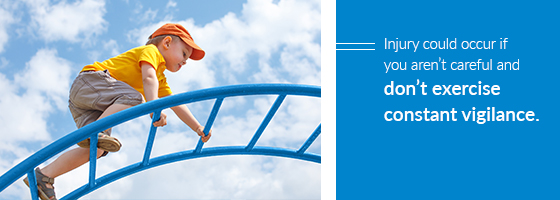
5. What Is the Company’s Reputation?
When you’re deciding who to buy a playset from, there are all kinds of factors on your mind. You’re probably considering how much their product costs, whether or not they have the product you’re looking for and if they’ll install it for you.
But if you’re seriously considering buying from a particular company, it’s also a smart idea to do a little extra research and see what their reputation is. Make sure they have a good reputation and they’re known for producing safe, reliable playsets.
There are a few ways to do this. You might ask friends who have backyard playsets. What company did they buy from? What did they think of them? You can also browse discussion boards and review websites online. If you consistently hear negative things about a particular company, you might want to avoid them. On the other hand, if you keep hearing good things about a certain company, it might be worth it to check out their products.
6. Are There Any Basic Safety Hazards?
This question doesn’t refer specifically to any one element of the playset, but rather to the small details that hold the playset together. If these little details are not cared for and are not being properly maintained, the entire structure quickly becomes unsafe.
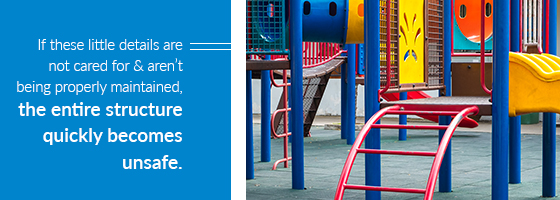
This will happen no matter what levels of precautions you’ve taken with the rest of the playset. Even if the playset is age-appropriate, installed on a soft surface and built from the correct materials, it can still be dangerous if youo neglect some of these basic details.
Some of the basic elements that require attention are:
Tightening the Bolts
Whether your playset is made of metal, wood or plastic, these materials all shift and change as time passes and seasons change. Bolts become loose in the winter or as children play and swing on the bars and pieces of the playset. Make sure to tighten these before the kids return to the playset for the summer, and then again every few weeks during the summer play season.
Checking for Bolt Caps
Exposed bolts could scrape or even cut bare knees and arms. Not only that, but they could also catch loose fabric, causing children to stumble, fall or even be caught and strangled by their own clothing. Bolts ought to be covered with a plastic cap that protects against the sharp edges of the bolt. Always check to make sure these caps are intact, and be sure to replace any that have fallen off.
Closing the S-Hooks
All S-hooks in your playset should be closed tightly enough that you can’t fit a dime through the opening. If they’re open wider than this, clothing could catch and cause a strangulation hazard, or the swing might come detached if the child swings too high. Use a pair of pliers to pinch these hooks closed to ensure this doesn’t happen.
Removing Extra Ropes
Kids are smart, and they’re always looking for ways to expand their play areas. Unfortunately, they don’t always have an accurate gauge of what’s safe and what isn’t. They might attach extra ropes like clothesline or jump rope to the playset and swing on them. This is a safety hazard because of the potential for strangulation, and also because they might be secured improperly and could cause a nasty fall.
Checking for Wear and Tear
One of the biggest safety hazards on any playset is simple wear and tear. You should always give your playset a thorough inspection after winter and before the start of the summer play season, as well as checking it multiple times during the summer. During this inspection, you should sand down splinters and check to make sure any chains and ropes are still secure. If necessary, give your playset a fresh coat of rust-resistant paint.
Making Sure the Area Is Clear
It’s important to ensure that the surrounding area is clear of any obstructions that might pose a danger. Are there any low-hanging tree branches, or drooping telephone wires? Are there any large fences nearby, or sheds that are too close? This is especially important when considering swings and how far they will travel in either direction. It’s also a good idea to check for any hazards hidden in the sand, mulch or other loose cover material.
Enjoy Your Safe Playset
This is by no means an exhaustive list of all the safety questions regarding playsets, but it hits the most common and pressing concerns. By attending to these safety measures, you and your family can have a safe playset that all of you can enjoy for years to come. If you’re considering purchasing a safe backyard playset for your family, look no further than Superior Play. We offer a wide variety of playsets and other playground equipment. We work hard to become the safest supplier of playground equipment in PA, NJ, NC and GA. We don’t just sell equipment.
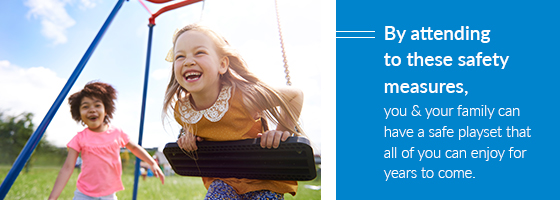
If you’re considering purchasing a safe backyard playset for your family, look no further than Superior Play. We offer a wide variety of playsets and other playground equipment. We work hard to become the safest supplier of playground equipment in PA, NJ, NC and GA. We don’t just sell equipment.
Looking for even more safe yet fun options for your backyard? Learn more about our Springfree trampolines that eliminate the hard metal springs typically found around a trampoline!
All of our products are carefully designed with safety in mind and tested extensively to ensure the safest experience possible for your child. Check out our online catalog of playsets and see what looks right for your family.

